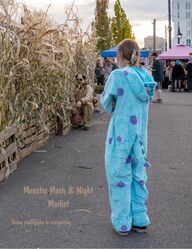
Return to flip book view
Message Monster Mash & Night Market Using photogrphy in storytelling
On the evening of Friday, October 11th, 2024, the parking lot of the U-District Gateway Bridge underwent a fascinating transformation into a pop-up street fair with a Halloween theme, casting a spell on all who entered from 5 to 9 PM. The air was filled with the tantalizing aromas of prepared food and treats. At the same time, live music from the band welcomed visitors with an enchanting melody even before they set foot inside the event grounds. The night market and street fair offered a spellbinding fusion of a vendor fair, music festival, immersive art experience, and a themed costume party, promising something for everyone, regardless of age, and ensuring a delightful time for the entire family. Many visitors fully embraced the Halloween spirit, arriving in elaborate costumes that added to the magical atmosphere of the evening. In addition to the live music, there were spine-tingling attractions for visitors to brave, including a fun house and captivating performance art throughout the event space. The fair featured approximately 40 vendors, showcasing diverse offerings, such as local cuisine, artisanal crafts, and vintage treasures, for visitors to explore and enjoy. As a student of photo arts and someone passionate about developing my skills, I saw this event as a golden opportunity to hone my storytelling skills through photography. I approached the event with a keen eye for the four essential elements of a photo story: the establishing shot, portrait, action, and detail. What are these elements, and why are they necessary to a story? The establishing shot is usually a wide-angle image of the event or place; this allows the viewer to put themself into the story. When done well, the establishing shot will leverage the viewers' wanting more and pull them into the story. Next, the portrait helps to showcase a person who is part of the story. The picture helps to introduce the human element to a story and to build a connection with the viewer. Then, the action shot helps to show what is happening in a story. This helps to move the story along and bring life to the story. Finally, the detail shots help to add delicate nuance to the story. When done well, detail shots help to make the viewers
feel like they are part of the story being told and pull them even deeper into the story. Using my knowledge of the four types of photos, I began by seeking out images to fill my shot list, aiming to capture the essence of the event and ensure that I would have the necessary components to weave a compelling visual narrative afterward. I focused on capturing the imagery required for a cohesive story without worrying too much about the story I would tell later. I only looked for creative ways to capture images for each type of shot. After getting a better feel for the event and the space, I sought to unleash my creativity with more unconventional shots while strolling around the event space. Ultimately, I remained open to capturing those spontaneous, fleeting moments that emerge when least expected. After strolling through the event for some time and becoming more familiar with my surroundings, I started preparing for the night's unfolding events by planning to return often to the areas I had identified that had the potential for something interesting to happen, putting myself into place likely to have a decisive moment occur. Having already captured images that ensured I could fulfill the minimum requirements allowed me to immerse myself in the mindset of photographing an event and enabled me to be more open to the moment. Subsequently, I experimented with unique angles and camera placements to capture pictures that diverged from the ordinary. Finally, I allowed myself to wander through the event, seeking out and seizing those serendipitous moments that presented themselves, ready to be immortalized through the lens of my camera. Following the event, I allowed myself some distance before reviewing the images, ensuring a clear and unbiased assessment. This allowed for better judgment of the pictures I had created and helped me select the most impactful photos for the storytelling process. Through culling my images and sequencing them into a story, it was hard to pass on some of my favorite images from the event. However, they did not add to the story and had to be set aside to help tell a better story. Practicing this process over and over, curating images and crafting a narrative around them, helps me become a better storyteller. We see what works and does not enhance my intuition while in the field, capturing moments through my lens and making my photography more impactful. Combining the story with the images we create can make both more meaningful than either can be alone. If our goal as photographers is to share the world around us, then all we have is the stories we share and the images we make along the way.
Waypointphoto.com